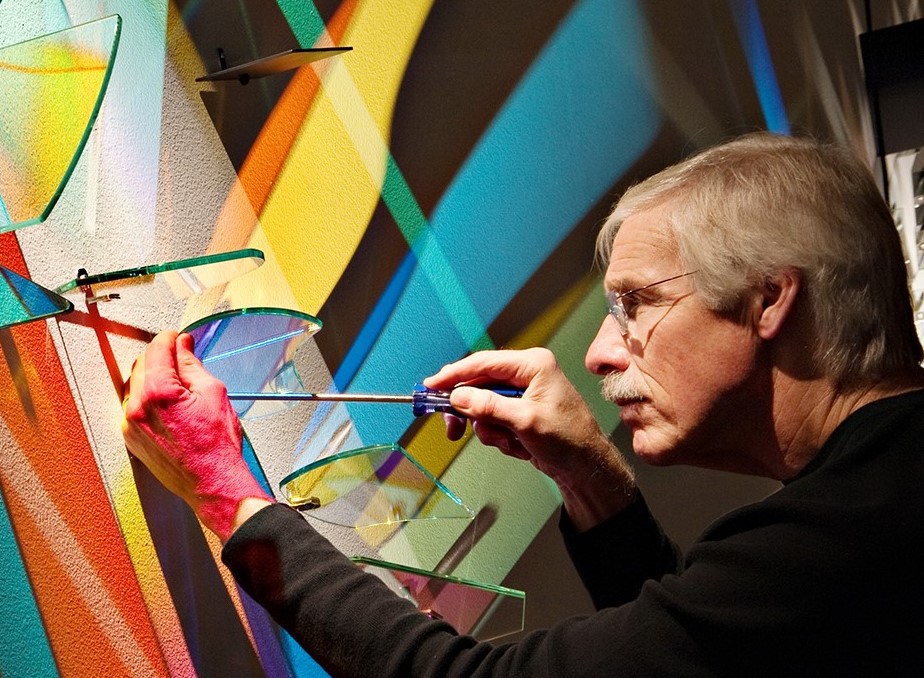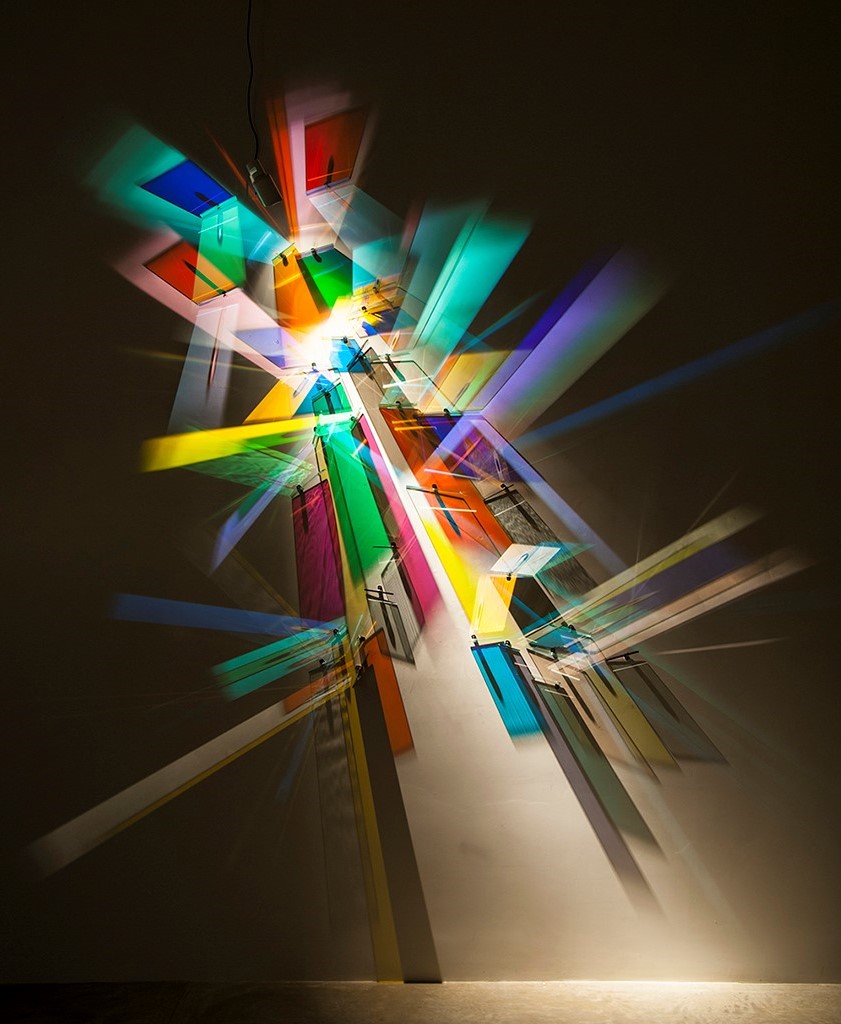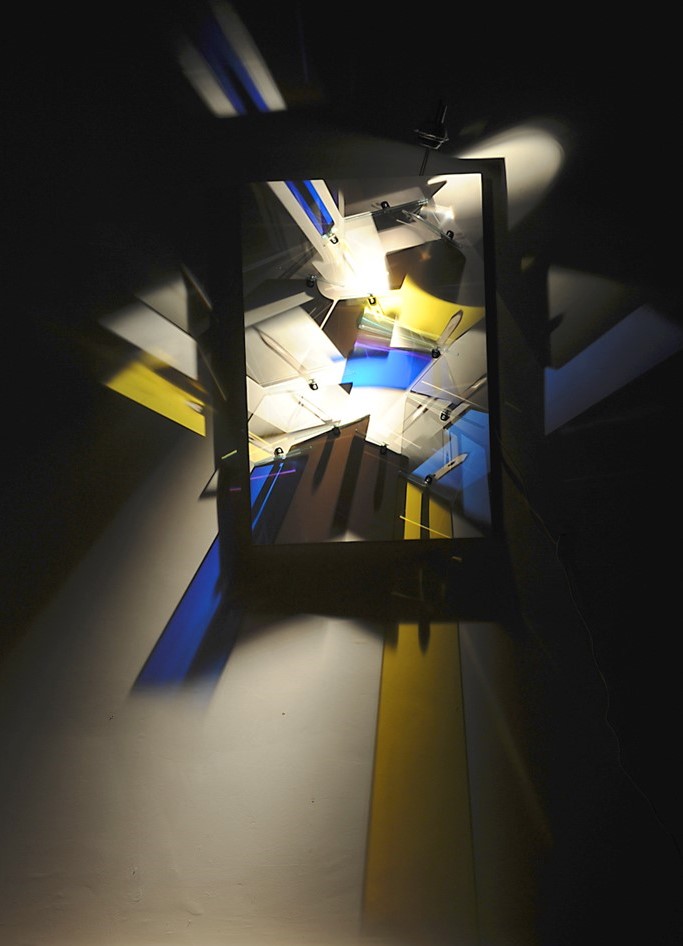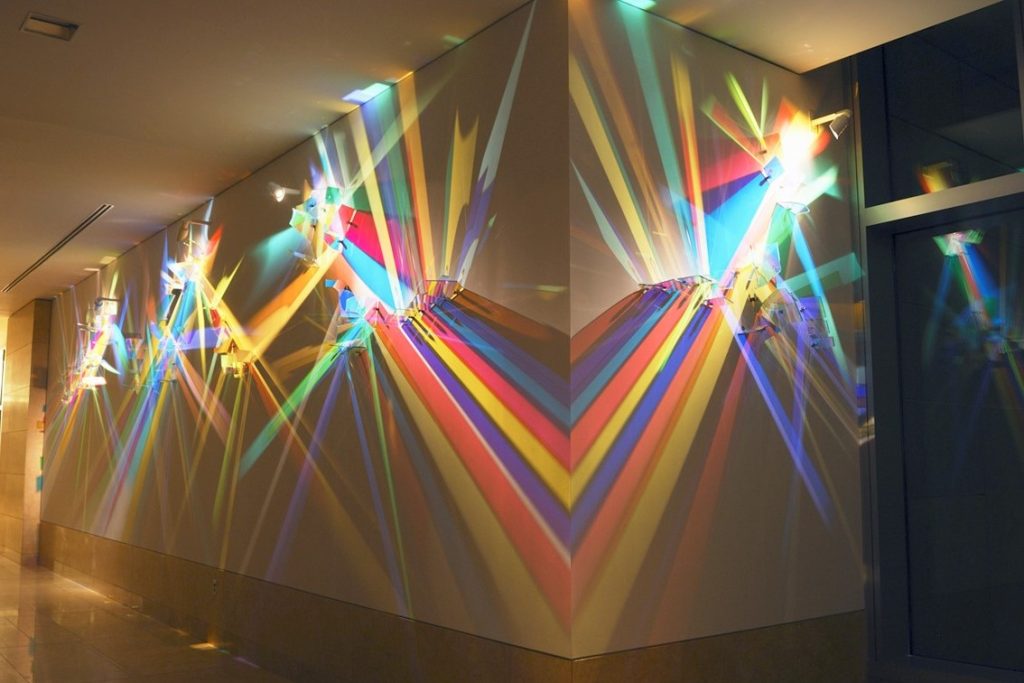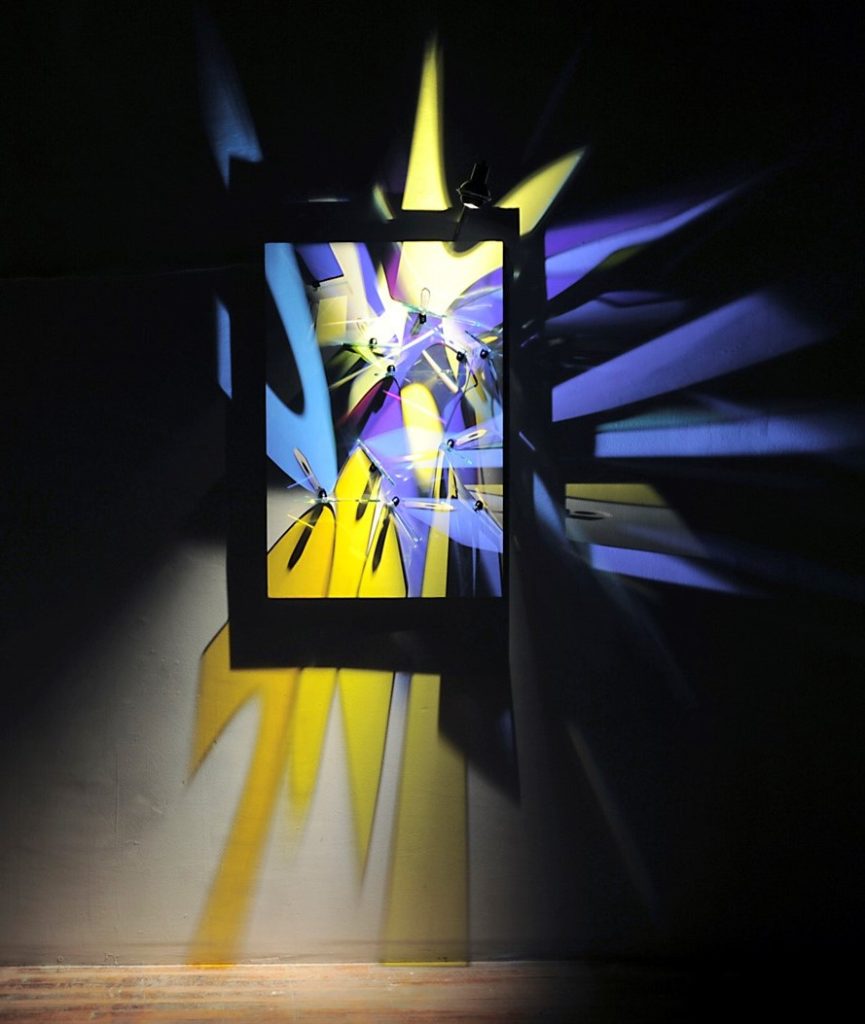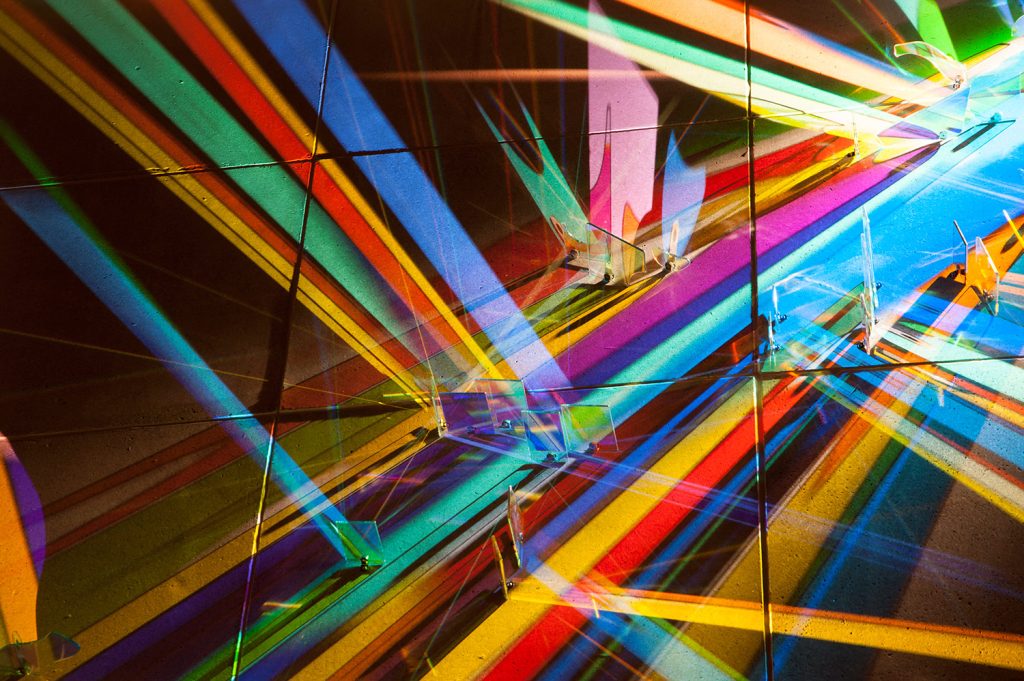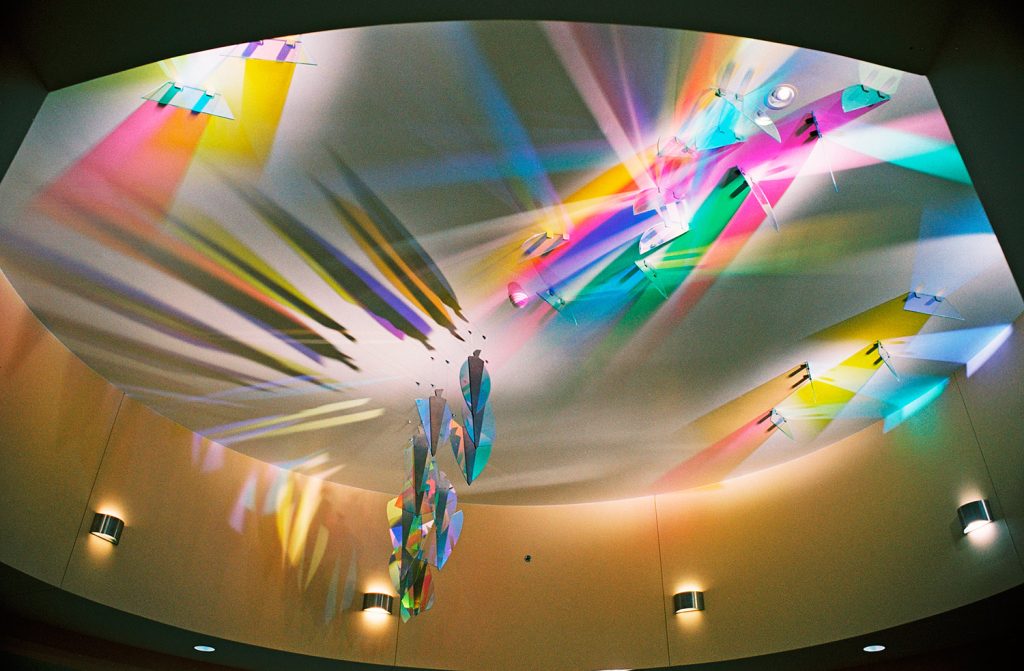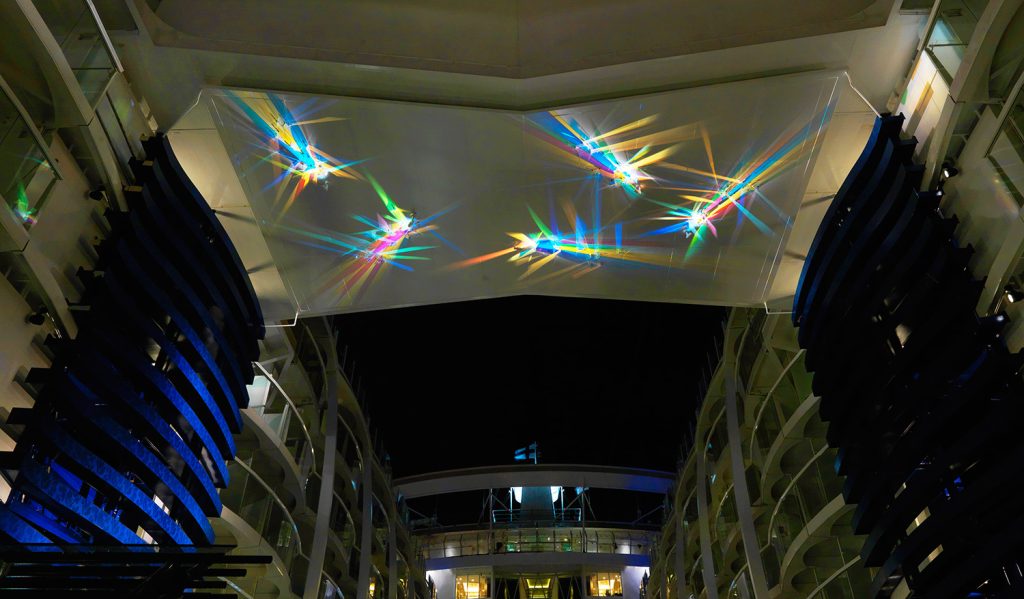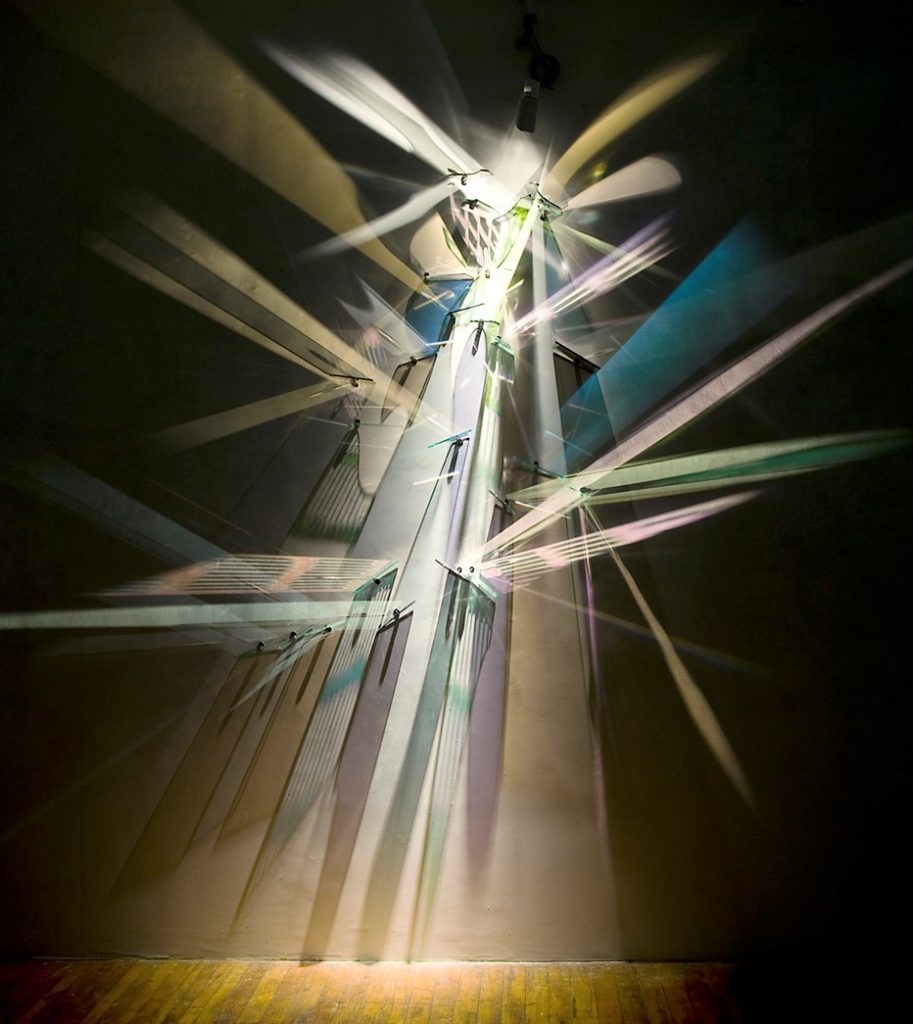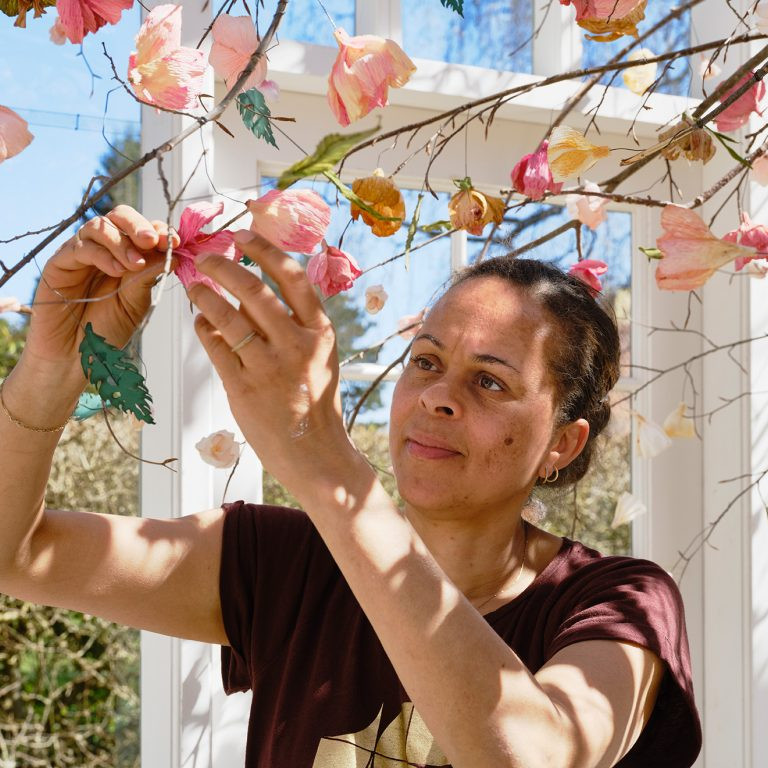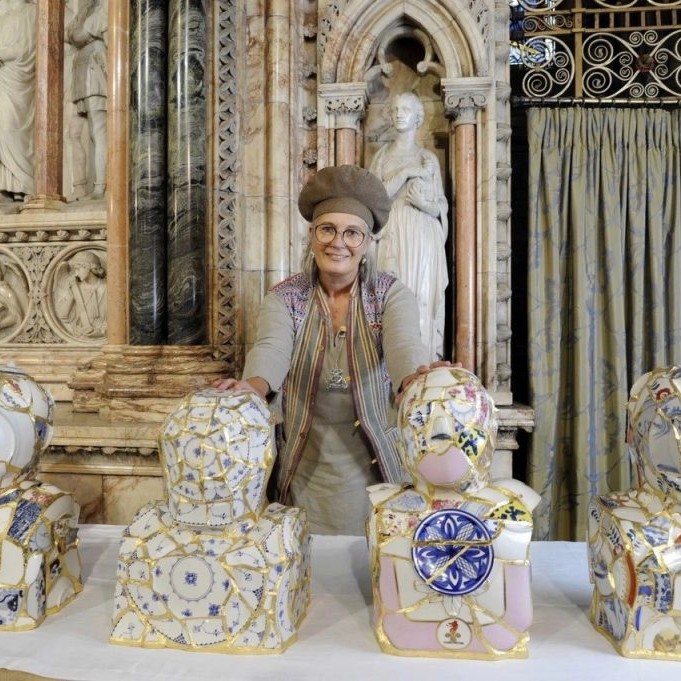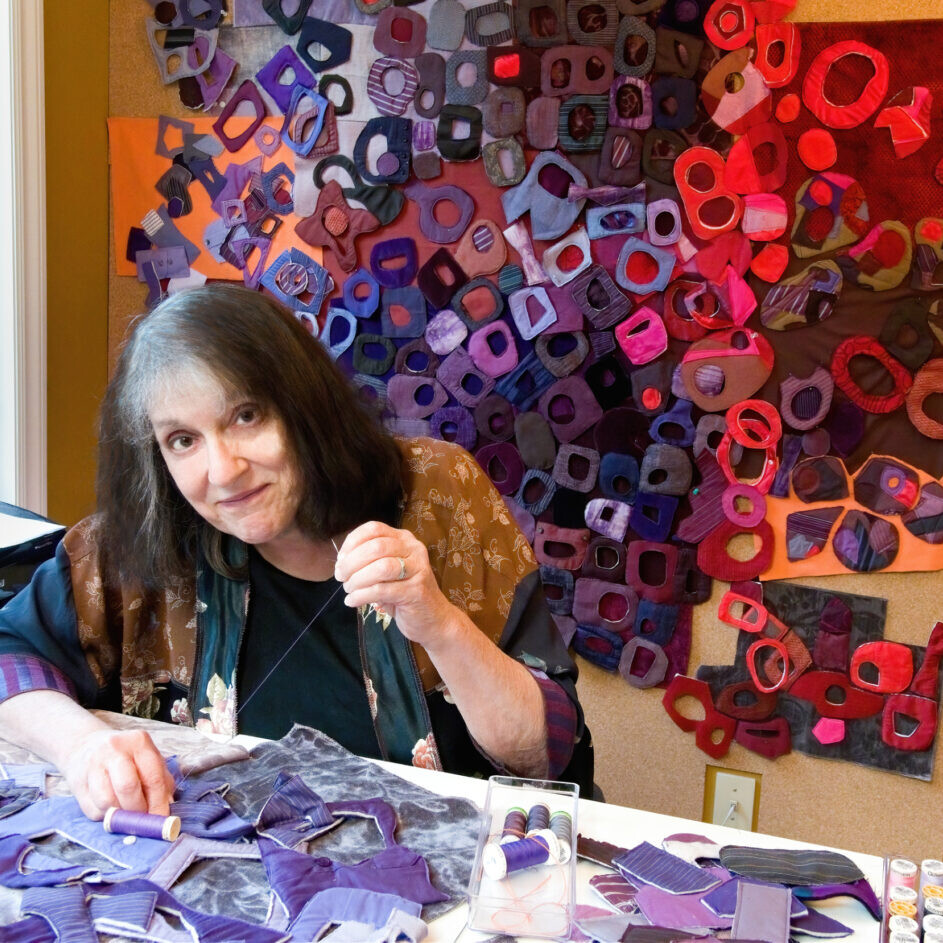Stephen Knapp Light Artist - Princeton, MA, September, USA
Can you explain briefly the technique you use to produce your lightpaintings?
Working with shapes that I have drawn my assistants cut and polish laminated dichroic glass and other variations we have developed. The glass is then mounted to specially fabricated stainless steel brackets and this large selection of pieces becomes my palette. Using these pieces of glass, I physically manipulate the light on the wall or on panels, separating white light into pure colour and painting with light.
Into the Narrows, Light, glass, stainless steel, 13’x 11’x 1″
What is so different about dichroic glass?
Dichroic Glass is produced by a process called deposition coating or thin film technology. Sheets of glass are coated with multiple layers of metallic oxides in a vacuum chamber. The resulting material transmits one colour – wavelength – of light while reflecting the complementary colour.
In the daytime different changing images are created when the sun comes over the building and strikes the glass.”
Dark Victory, Light, glass, stainless Steel, panel (36”x 24”) 8’ x 5’ x 10”
Can you explain the different ways ‘The Definition of Possible’ is reflected in the day and that at night?
“The Definition of Possible” takes on many forms. Its most striking form, as created in the studio and at night, is made up of brilliant colours. Ambient light plays its part here as the lightpaintings will lighten or darken depending on the light that surrounds it. It can appear in full colour during the daytime when storm clouds come over and darken the area, and then lighten up again, only to deepen as it moves into night.
Daylight – what is the role of daylight in your work?
Daylight is a different matter. A lightpaintings can nearly disappear on a bright day, leaving wonderful, subtly glowing sculptural shapes in its place. When sunlight hits the glass directly brilliant colour appears once more, the length and width determined by the angle of the sun. This changes not only as the sun moves through the arc of the day but as the seasons turn the position of the sun moves, changing the image.
Light has been such an important aspect of art in the late 19th 20th and 21st Centuries in painting and photography. Now you have taken it to another level through technology, discuss?
From the earliest days people have expressed themselves in pigment and light has played an important role as they sought to capture it. Viewing paintings of the past few centuries one can see the importance of light. The ways to capture it has changed, mirroring the history of art. The difference for me is that instead of using paint to capture light I’m actually painting with light, taking it a giant step forward.
How are you able to control the distance (length – width) of each shaft of light in your work?
The length and width of each shaft of light is determined by the distance from the light to the wall and the distance from the light to the glass. For the reflected light I have developed a series of techniques to give me even more control..
‘Transformation’ copes with corners discuss.
In “Transformation” the act of bending light around a corner is an act of illusion, albeit an extraordinarily difficult one to do. Light travels in a straight line. I have “curved light” before but had never tried to make it look like the light was bending around a corner. Each time I create a lightpaintings I challenge myself to do something new, to push myself and learn more. “Transformation” was an idea that I knew would be difficult to accomplish. I just did not realize how difficult.
Transformation, Light, glass, stainless steel, 14’x 85’x 64’6″
How do you stop the light from protruding onto the ceiling?
Controlling how far the light goes happens in the creative process. Whenever possible I use ceilings, walls or floors as part of my canvas.
How does your work relate to wattage? (electricity)
Although it is counterintuitive, my lightpaintings are actually “green”. Lightpaintings use light so efficiently that I am able to work with architects and designers to lower light levels in a building to reduce electricity. Each light uses a 50W or 75W fixture and a single installation piece uses only one 75W lamp.
What colours can you achieve?
With basic dichroic glass there are limitations in colours. Working with manufacturers I’ve been able to greatly expand my palette. By mixing colours and using various twice reflected colours I’m able to achieve even more. I also use different techniques in the laminating process to add more shading. Surprisingly, coming up with a good range of greys has proven to be a more difficult task.
What Isn’t It, Light, glass, stainless steel, (panel 36”x 24”) 9’x 6’x 10”
Can you explain the difference between reflection and refraction of light?
Refraction is a change in the direction of light going through a medium, such as glass, crystal or water. With dichroics, it refers to the transmitted color caused by the light passing through the treated glass. Reflection refers to the light reflected back, as it would from a mirror.
Discuss how your work is used with music?
My largest installation is “Luminous Affirmations” at 80’ x 60’ x 20”. This project was sponsored by the City of Tampa, Florida as the first piece of what has become a very popular “Lights on Tampa” Program. Using the blank wall of City Hall as a backdrop, this 80’ x 60’ lightpaintings uses specially designed 300W ceramic metal halide fixtures. A signature public art installation for the City of Tampa it is often featured in overviews of the city in sporting events and other televised events.
First Symphony, Sursa Performance Hall at Ball State University, Muncie,IdianaLight, glass, stainless steel, 23’x 40’x 12
What is the largest installation you have done?
My largest installation is “Luminous Affirmations” at 80’ x 60’ x 20”. This project was sponsored by the City of Tampa, Florida as the first piece of what has become a very popular “Lights on Tampa” Program. Using the blank wall of City Hall as a backdrop, this 80’ x 60’ lightpaintings uses specially designed 300W ceramic metal halide fixtures. A signature public art installation for the City of Tampa it is often featured in overviews of the city in sporting events and other televised events.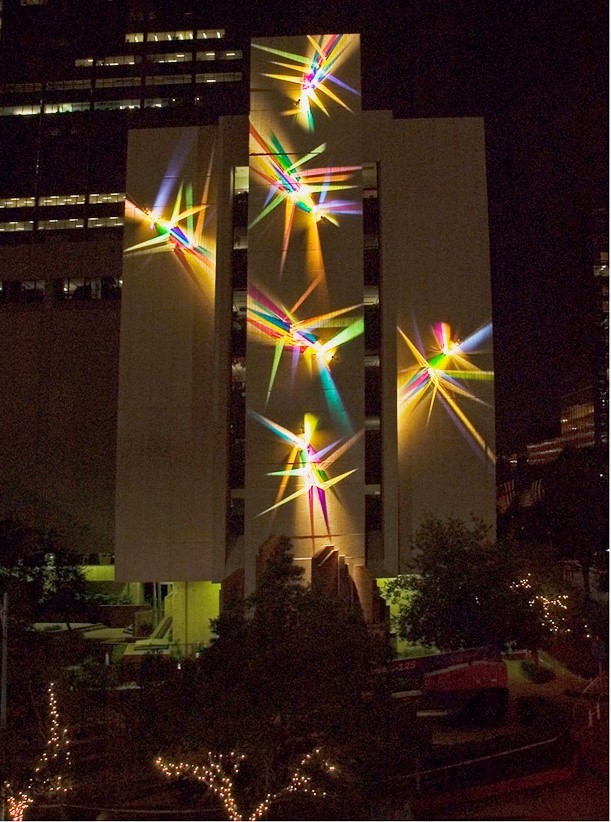
Luminous Affirmation, Light, glass, stainless steel, 80’ x 60’x 20”
In large installations how does the background (brick, concrete blocks, painted walls) effect your work?
Backgrounds are very important to my work. Instead of a shiny, reflective surface which many people expect, I look for the least reflective surface I can get. For interior spaces that is usually a flat light coloured paint. I’ve installed lightpaintings on stucco walls which create a bit of shadow which diminishes the saturation of the colour. Still very nice – just different. The best exterior surface I’ve found yet is the precast concrete used for “The Definition of Possible”.
Definition of Possible, detail
How do you classify your art?
I refer to myself as an artist, an installation artist who works with light, or a light artist – never a glass artist. Light is my primary medium; glass allows me to manipulate it to create lightpaintings.
Your work ‘Stories from Light’ at the Women and Babies Hospital in Pennsylvania.
“Stories from Light: started with a request for a stained glass ceiling – pretty interesting request for an artist who had never done stained glass.
I had just completed my first architectural scale lightpaintings and it just seemed to be a better answer for the space. When I realized that a lot of babies were born in this hospital the idea to add these sculptural abstract human elements coming out of a rainbow just spoke to me.
You have work inside and outside large galleries but also on large ships. Discuss the work on the Royal Caribbean Cruise Liners.
Royal Caribbean Cruise Lines has been an interesting client, one willing to take chances. My first commission for them consisted of two installations. The first, “Fragments of Time – the Explorer’s Legacy”, on Splendour of the Seas was a wall of kiln formed art glass and marble 4′ 4″ x 43′ x 24″. The second was “Answered Prayers and Mystery – the Night Sky Revisited”, also on Splendour of the Seas, consisted of mosaic tile and stainless steel, 5′ 6″ x 65′ x 2′ 8″. These led to my most recent commission, “Trailing Light”.
“Trailing Light”, is a 35’ x 50’ x 12” installation on an outdoor ceiling of Oasis of the Seas.
Oasis of the Seas.
One of the trickiest parts of this installation was setting it up so it could be installed in a shipyard in Finland without my presence. Although all my installations are created for exterior use, for this one the lights were double anodized for another layer of protection.
Your studio is so white, expand on this in relationship to the work you create.
My white studio is simply a blank page upon which I can create. It also is great to showcase the sculpture, mosaics, furniture and other work I have done.
My wife Frankie manages the studio and she oversees everything I don’t do. I usually have two assistants who do installations, glass fabrication, boxing, shipping and the rest of the work.
Keeping the studio staff small allows me the freedom to experiment and spend time on research. I find this a much better model for me than the larger studios of friends who complain about how they have to work constantly to “feed the beast”.
My work is computerized in terms of the business end of the studio. I use Photoshop for renderings or to help me block out a wall as far as light spread etc., which gives me starting points for the light locations on large installations. I do not use it for creating lightpaintings at all.
Do you see yourself as the creator of modern rainbows?
I actually don’t think of my work at all in terms of rainbows, except for “Stories from Light”. Ever since then it has been all about painting with light. A visit to my studio would show brightly coloured lightpaintings alongside monochromatic pieces and pieces with textured and patterned glass, all in the service of moving forward and learning more about this amazing medium.
Glass allows me to manipulate and explore light and illusion; perception and dimension. I revel in the purity of the colours, their breathtaking richness, yet I am most drawn to the edges and the soft shadows that overlay a whisper of colour and the borders that define space. It is here that mystery and depth and wonder can be found.
Perception and interaction lead to an act of mutual discovery, a universal bond of our existence. There is no right answer hidden within each piece, only a shared journey.
False Prophet, Light, glass, stainless steel, 13’x 15’x 1″
Contact details:
Stephen Knapp
“Lightpaintings by Stephen Knapp” documentary on YouTube
Stephen Knapp, Princeton, MA, September, USA
Interview by Deborah Blakeley, September, 2016
Think a colleague or friend could benefit from this interview?
Knowledge is one of the biggest assets in any business. So why not forward this on to your friends and colleagues so they too can start taking advantage of the insightful information the artist has given?
Other artists you may be interested in:


